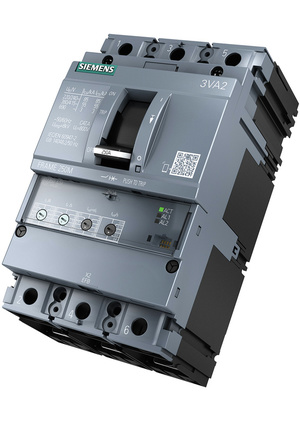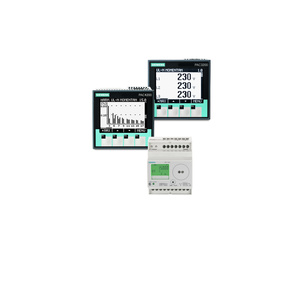News Release from Siemens Gamesa Renewable Energy
Wind Industry Profile of
Working perfectly together: automation and power distribution in wind turbines
Falling costs are playing a crucial role in the global expansion of energy generation using wind power. In general, it is still more costly to generate electricity from wind turbines than from coal. And so, in offshore wind farms in particular, plant manufacturers, operators, suppliers and construction companies are combining forces to reduce the costs of installing and operating these systems. Siemens wants to refine its technology to make it possible for wind turbines on the open sea to generate electricity for 10 cents per kilowatt hour by as early as 2020.
Wind turbine manufacturers have often based their purchasing decisions on the best prices for each individual component used in the plant. This initial cost saving, however, may prove more costly sooner or later as a consequence of reduced plant availability, simply because the cost of integrating the components from different manufacturers was underestimated. On the other hand, the alternative – obtaining everything from a single source – is often not desired. The widespread view is that an all-round solution could lead to higher costs and also to a dependence on a single supplier. A middle ground involves packaging and modularizing individual components.
Prefect interaction – the core theme of the Siemens presence at WindEnergy Hamburg 2014
The automotive industry is the perfect example of parts optimally working together thanks to modularization: common platforms are used for different models, with as many shared system components as possible, and this method can be transferred to the manufacturing of wind turbines.
This is why Siemens is offering wind turbine manufacturers a comprehensive, future-proof portfolio of products. It is based on platform strategies, modularization and standardization, and covers everything from automation, display and process control technology to communications, switching technology, power distribution, pitch and yaw drives, and the generator systems to provide power. Security systems and protection against fire are also added into the mix. All products and systems optimally working together guarantees the wind turbines will operate efficiently and reliably.
The importance Siemens attaches to error-free interaction between all components in a wind turbine was evident at the industry trade fair WindEnergy Hamburg (September 23-26, 2014). After all, components and systems must be perfectly coordinated to ensure consistently high power yield with minimum lifecycle costs. The technical preconditions for structured networking of components in a wind turbine – and an entire wind farm – are met by industrial communications based on Industrial Ethernet, which Siemens offers in the network components from its Scalance series.
Adding a control room at the WindEnergy booth demonstrated how all plant components working together actually functions in practice. The control room operates using the WinCC OA display system, the scalable, open and end-to-end SCADA software to ensure the ideal operation of wind turbines and wind farms. Simulated “use cases” – instances of application arising in real life – can be triggered under realistic conditions, and the reaction by the system can then be observed “live”.
Safe, efficient power distribution for low and medium voltage
An additional focus of Siemens’ presence at the Hamburg event was the question of power distribution in wind turbines. In specific terms: the safe and efficient distribution of the generated power in the main and secondary circuits through to safe grid feed-in.
The safe, low-loss transmission and distribution of power in the plant are assured by Sivacon 8PS busbar trunking systems. Compared to PVC-insulated cables, the steel plate casings of the busbars have a much lower fire load. Other positives for the busbars are high short-circuit resistance in the tap-off units and a higher thermal power rating in the event of lightning strikes.
Perfectly coordinated protection, switching, measuring and monitoring devices of the Sentron family are available to provide low-voltage power distribution: the 3WL open circuit breaker thus provides reliable protection in the main circuit, protecting the generator and converter against short circuits and overloads. Integrated into the turbine’s distributed control system, the switch can be queried or operated by remote. In the main circuit, the Sitor semiconductor fuses protect the power semiconductors in the converters against uncontrolled failure – thus avoiding significant consequential damage. The Siemens protection system in the main circuit also includes overvoltage protection designed to suit each particular type of plant to ensure a high level of functional safety and plant availability.
The industry fair also presented a special highlight for a high infeed protection for auxiliary circuits of wind turbines: the new 3VA molded case circuit breaker provides reliable protection for lines and electrical consumers in auxiliary circuits against damage and outages caused by short-circuits and overloads by safely cutting off the current. The improved selectivity characteristics of the 3VA molded case circuit breaker help boost plant availability, as power is cut only to those parts of the system that are actually affected by a fault.

Molded case circuit breakers in the 3VA2 series are fitted with an electronic trip unit (ETU), including a measuring function that records current, voltage and power values. Switch status, threshold values and maintenance information can also be communicated to the wind turbine distributed control system and the wind farm management. Remote operation using a motor drive is also possible.
The gas-insulated 8DJH 36 medium-voltage switchgear can be used as a hub for medium-voltage power distribution in various wind power applications. These offer impressive advantages in both onshore and offshore wind farms: the use of maintenance-free switchgear, a plant casing constituting a hermetically sealed pressure system and solid-insulated, de-energized cable end bushings makes the plant maintenance-free for life. A further outstanding characteristic of the 8DJH 36 is its compactness and flexibility. Its modular structure allows functions to be arranged variably – both within a panel block and as part of more complex switchgear layouts.
Switching, protection and starting of motors and drives
Safety and efficiency are also required for controlling motors and drives. This affects not only the motors in the pitch and yaw systems in a wind turbine, but also the many auxiliary functions such as fan or hydraulic systems. In this area, Sirius switching systems offer a wealth of functions for switching, protecting and starting motors. They also stand out on account of their high contact reliability and compact construction. Their particular robustness and long service lives are also impressive – even under extreme environmental conditions. Products for monitoring and controlling, recording, conveying instructions, reporting and supplying round out the range of the Sirius system toolbox.
Sirius switching systems also provide remote querying and remote control options via the SCADA system in a wind turbine or wind farm. And that pays off: any faults that occur can be identified at an early stage and be averted by preventive maintenance measures. Because the control functions are provided by remote, there is no need to dispatch maintenance personnel to the turbine, which offers a substantial cost advantage, especially for offshore systems.
Safe separation from the grid for maintenance work
The new 3KD switch disconnector ensures reliable personal protection and a high level of plant availability. This keeps a tight lid on electrical accidents during maintenance work, since the 3KD switch disconnector uses a locking device to prevent unauthorized switching. In addition, transparent contact covers make it possible to identify the contact settings at all times without error. With its range of applications, the 3KD switch disconnector can be put to many different uses in wind turbines, whether as a main switch, emergency cutoff or repair switch.
Control and simulation software for wind turbines
Safe power distribution within the turbine ensures a high level of plant availability. Achieving the best possible capacity from each individual turbine in a wind farm simultaneously requires powerful simulation and control software. If both of these categories of software work together in wind turbines without problems, the result is noticeable benefits for both plant manufacturers and plant operators. Adapting Siemens’ real-time-capable WinAC RTX software PLC to the well-known simulation program Matlab/Simulink creates the perfect synergy between two world-leading, tried-and-tested systems: while the simulation software optimizes the plant control system, the PLC feeds back information obtained from the operation of the plant itself.
Siemens solutions for the complete automation of wind turbines enables the plant control system to be individually oriented to the situation on-site: rotation, blade length and design, imbalances, powerful or gentle wind conditions, gusts and other factors are all carefully considered to guarantee the best possible plant operation and thus maximize electricity revenues.
If the control system can respond more precisely to actual wind and operating conditions, this in turn enables the construction of wind turbines to be optimized in greater detail, which will help achieve further cost reductions in future: feedback from the control level to the simulation offers design engineers and developers of wind turbines the advantage of being able to perceive specific events – which in some cases occur only infrequently – and provide a targeted response to them.
Mobile access to system information at all times
For the operational management of wind turbines and wind farms, Siemens has developed the Multilevel Wind SCADA Center software application, based on Simatic WinCC Open Architecture. The Multilevel Wind SCADA Center, with its scalable, open and end-to-end software structure, is both a powerful wind farm SCADA for the optimal operation and observation of wind turbines and wind farms and a versatile service portal for wind turbines.
The Simatic WinCC OA OPERATOR app also enables the plant to be monitored and controlled easily using a Smartphone, giving the operating personnel online access to the plant at all times. An instant alarm function also means it can respond immediately, which saves valuable time and improves plant availability as a further consequence. The mobile application shows the process data, plant availability and the status of the plant. A complete alarm screen with filtering and sorting functions, individually definable lists containing values and orders and a map with defined plant locations and filtered alarms in each case guarantee an ideal overview.
Stationary energy storage system
It is well known that decentralized renewable energy sources such as wind turbines create new challenges in the areas of grid stability, integrating these sources into the grid, reserves of balancing energy, voltage and supply quality and peak load management. Siemens also offers solutions for these challenges with its stationary energy storage devices in the Siestorage series. This stationary and modular storage solution was developed in cooperation with one of the world’s largest lithium-ion battery manufacturers. With a compact battery and converter model as its smallest unit, the Siestorage energy storage device can be expanded to outputs in the range of two megawatt hours (MWh) and capacities of eight megawatts (MW).
Conclusion
All products and systems that Siemens makes available for wind turbines work together perfectly and guarantee maximum plant transparency and availability. They communicate seamlessly across all levels – from the smallest switch through to the higher-level control room. All plant components can thus be monitored comprehensively and are ideally controlled. Rapid and effective responses are also possible in extreme situations, to avert damage to the plant. Manufacturers and operators of wind turbines thus benefit from maximum availability and efficiency, low production and maintenance costs, a saving of engineering and commissioning time and shorter time-to-market for new wind turbines.

- Source:
- Siemens
- Author:
- Judith Ruppert, Marketing Vertical Market Management Wind, Siemens AG
- Email:
- support.energy@siemens.com
- Link:
- www.siemens.com/...

